check engine Oldsmobile Achieva 1995 Owner's Manuals
[x] Cancel search | Manufacturer: OLDSMOBILE, Model Year: 1995, Model line: Achieva, Model: Oldsmobile Achieva 1995Pages: 340, PDF Size: 16.99 MB
Page 72 of 340
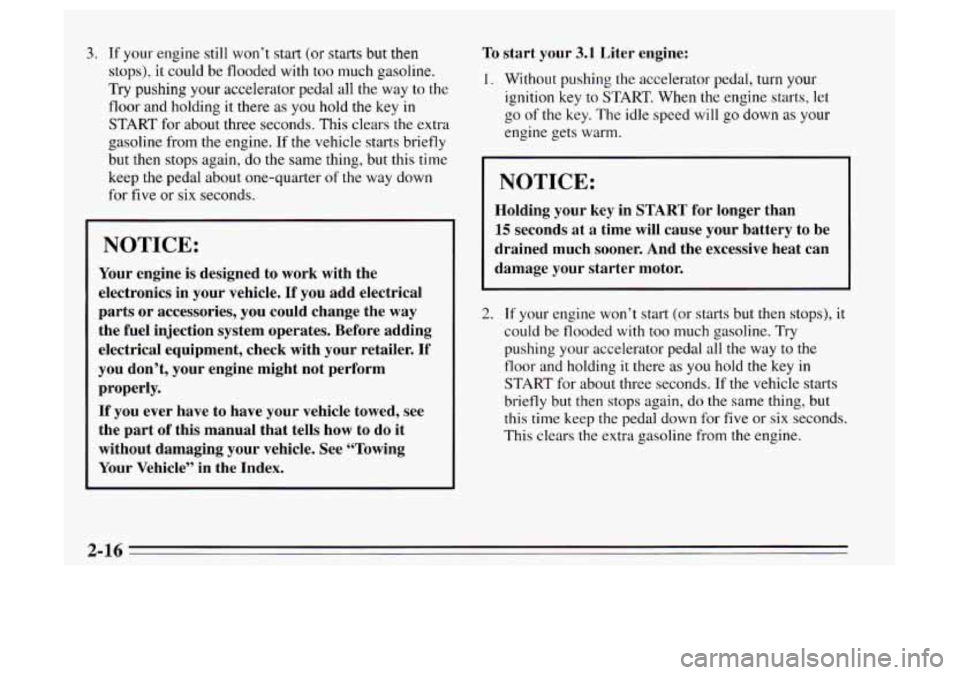
3. If your engine still won’t start (or starts but then
stops), it could be flooded with too much gasoline.
Try pushing your accelerator pedal all the way
to the
floor and holding it there as you hold the key
in
START for about three seconds. This clears the extra
gasoline from the engine. If the vehicle starts briefly
but then stops again, do the same thing, but this time
keep the pedal about one-quarter
of the way down
for five
or six seconds.
NOTICE:
Your engine is designed to work with the
electronics in your vehicle.
If you add electrical
parts or accessories, you could change the way
the fuel injection system operates. Before adding
electrical equipment, check with your retailer.
If
you don’t, your engine might not perform
properly.
If you ever have to have your vehicle towed, see
the part
of this manual that tells how to do it
without damaging your vehicle. See “Towing
Your Vehicle’’ in the Index. To
start your
3.1 Liter engine:
I. Without pushing t.he accelerator pedal, turn your
ignition key to
START. When the engine starts, let
go of the key. The idle speed will go down as your
engine gets warm.
NOTICE:
Holding your key in START for longer than
15 seconds at a time will cause your battery to be
drained much sooner. And the excessive heat can
damage your starter motor.
2. If your engine won’t start (or starts but then stops), it
could be flooded with too much gasoline. Try
pushing your accelerator pedal all the way to the
floor and holding
it there as you hold the key in
START for about three seconds. If the vehicle starts
briefly but then stops again, do
the same thing, but
this time keep the pedal down for five or six seconds.
This clears the extra gasoline from the engine.
2-16
-
Page 73 of 340
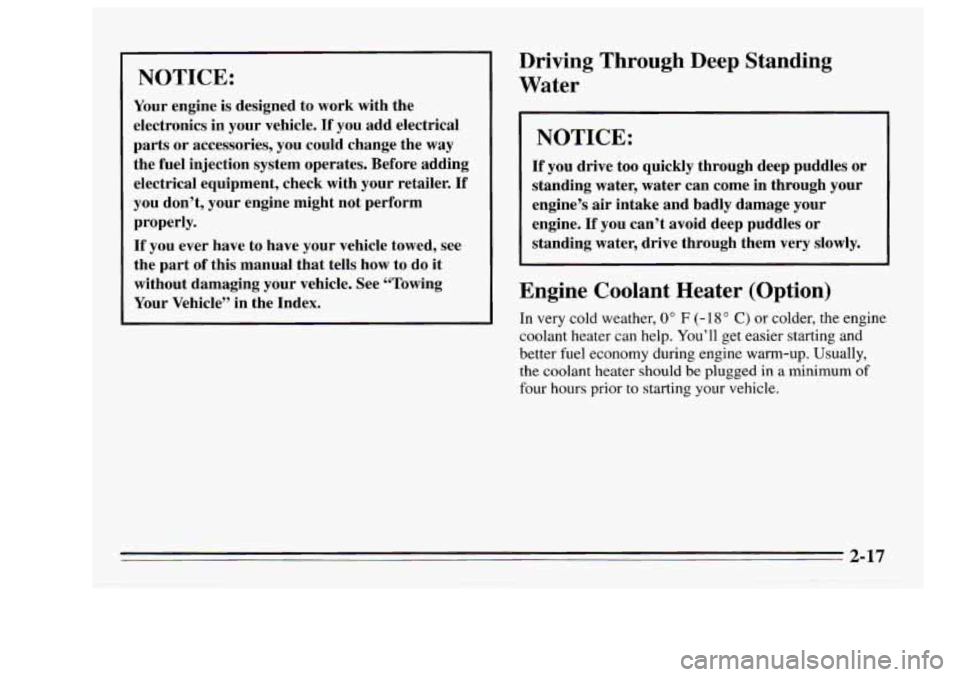
NOTICE:
Your engine is designed to work with the
electronics in your vehicle.
If you add electrical
parts or accessories, you could change the
way
the fuel injection system operates. Before adding
electrical equipment, check with your retailer.
If
you don’t, your engine might not perform
properly.
If you ever have to have your vehicle towed, see
the part of this manual that tells how to do it
without damaging your vehicle. See “Towing
Your Vehicle’’ in the Index.
Driving Through Deep Standing
Water
NOTICE:
If you drive too quickly through deep puddles or
standing water, water can come in through your
engine’s air intake and badly damage your
engine.
If you can’t avoid deep puddles or
standing water, drive through them very slowly.
Engine Coolant Heater (Option)
In very cold weather, 0” F (- 18 O C) or colder, the engine
coolant heater can help. You’ll get easier starting and
better fuel economy during engine warm-up. Usually,
the coolant heater should be plugged in a
minimum of
four hours prior to starting your vehicle.
2-17
Page 115 of 340
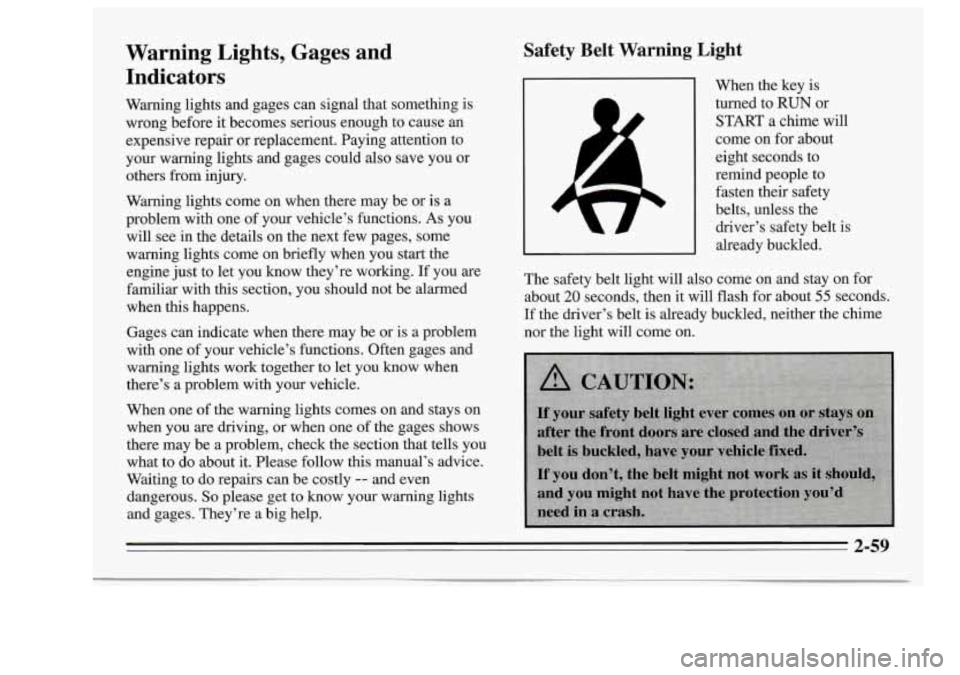
Warning Lights, Gages and
Indicators
Warning lights and gages can signal that something is
wrong before it becomes serious enough to cause an
expensive repair or replacement. Paying attention to
your warning lights and gages could also save you or
others from injury.
Warning lights come on when there may be or is a
problem with one of your vehicle’s functions.
As you
will see
in the details on the next few pages, some
warning lights come on briefly when you start the engine just to let you know they’re working. If you are
familiar with this section, you should not be alarmed when this happens.
Gages can indicate when there may be or is a problem
with one of your vehicle’s functions. Often gages and
warning lights work together to let you know when
there’s a problem with your vehicle.
When one of the warning lights comes on and stays on
when you are driving, or when one of the gages shows
there may be a problem, check the section that tells you
what to do about it. Please follow this manual’s advice.
Waiting to do repairs can be costly
-- and even
dangerous.
So please get to know your warning lights
and gages. They’re a big help.
Safety Belt Warning Light
When the key is
turned to
RUN or
START a chime will
come on for about
eight seconds to
remind people to fasten their safety
belts, unless the
driver’s safety belt
is
already buckled.
The safety belt light will also come on and stay on for
about
20 seconds, then it will flash for about 55 seconds.
If the driver’s belt is already buckled, neither the chime
nor the light will come on.
2-59
Page 116 of 340
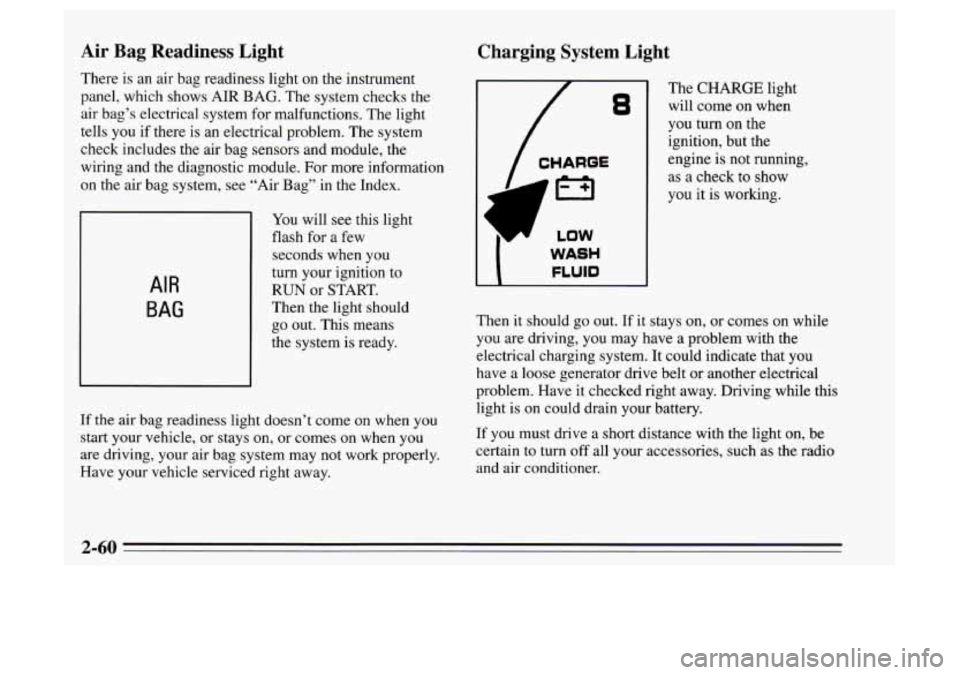
Air Bag Readiness Light
There is an air bag readiness light on the instrument
panel, which shows AIR BAG. The system checks the
air bag’s electrical system for malfunctions. The light
tells
you if there is an electrical problem. The system
check includes the air bag sensors and module, the
wiring and the diagnostic module. For more information
on the air bag system, see “Air Bag” in the Index.
AIR
BAG
You will see this light
flash for a few
seconds when you
turn your ignition to
RUN or START.
Then the light should
go out. This means
the system is ready.
If the air bag readiness light doesn’t come on when you
start your vehicle, or stays on, or comes on when you
are driving, your air bag system may not work properly.
Have your vehicle serviced right away.
Charging System Light
WASH
I FLUID
The CHARGE light
will come on when
you turn on the
ignition, but the
engine is not running,
as a check to show
you it is working.
Then it should go out. If it stays on, or
co !s on while
you are driving, you may have a problem with the
electrical charging system. It could indicate that you
have a loose generator drive belt or another electrical
problem. Have it checked right away. Driving while this
light
is on could drain your battery.
If you must drive
a short distance with the light on, be
certain to turn off all your accessories, such
as the radio
and air conditioner.
2-60
Page 119 of 340
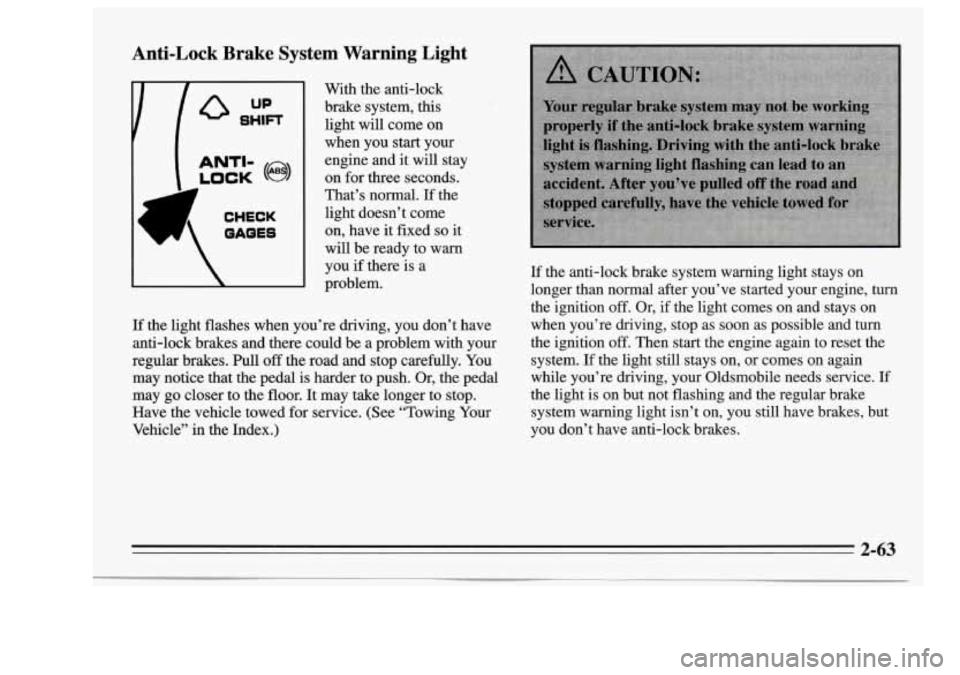
Anti-Lock Brake System Warning Light
‘A CHECK
OAQES
With the anti-lock
brake system,
this
light will come on
when you start your
engine and it will stay
on for
three seconds.
That’s normal.
If the
light doesn’t come
on, have it fiied
so it
will be ready to warn
you
if there is a
problem.
If the light flashes when you’re driving, you don’t have
anti-lock brakes and there could be a problem with your
regular brakes. Pull
off the road and stop carefully. You
may notice that the pedal is harder to push. Or, the pedal
may go closer to the floor. It may take longer to stop.
Have the vehicle towed for service. (See “Towing Your
Vehicle” in the Index.)
If the anti-lock brake system warning light stays on
longer than normal after you’ve started your engine,
turn
the ignition off. Or, if the light comes on and stays on
when you’re driving, stop as soon as possible and turn
the ignition
off. Then start the engine again to reset the
system.
If the light still stays on, or comes on again
while you’re driving, your Oldsmobile needs service.
If
the light is on but not flashing and the regular brake
system warning light isn’t on, you still have brakes, but
you don’t have anti-lock brakes.
2-63
Page 121 of 340
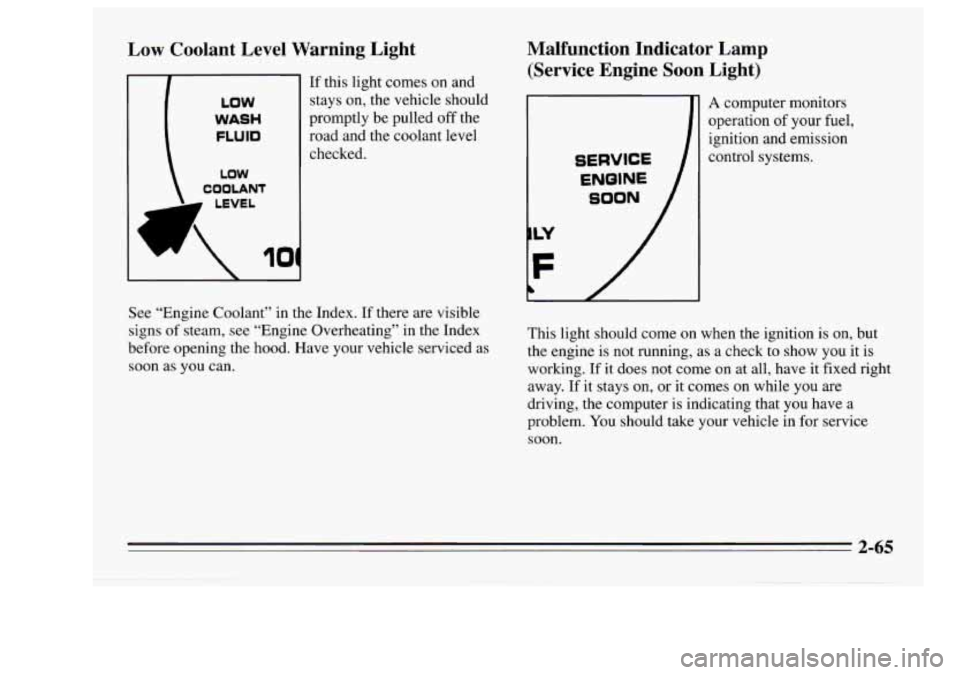
Low Coolant Level Warning Light
LOW
WASH
FLUID
LOW
COOLANT
1
If this light comes on and
stays on, the vehicle should
promptly be pulled off the
road and the coolant level
checked.
See “Engine Coolant”
in the Index. If there are visible
signs of steam, see “Engine Overheating” in the Index
before opening the hood. Have your vehicle serviced as
soon as you can.
Malfunction Indicator Lamp
(Service Engine Soon
Light)
I
LY
SERVICE
ENOINE
SOON
A computer monitors
operation of your fuel,
ignition and emission
control systems.
This light should come on when the ignition
is on, but
the engine is not running,
as a check to show you it is
working. If it does not come on at all, have it fixed right
away. If
it stays on, or it comes on while you are
driving, the computer is indicating that you have a
problem. You should take your vehicle in for service
soon.
2-65
Page 122 of 340
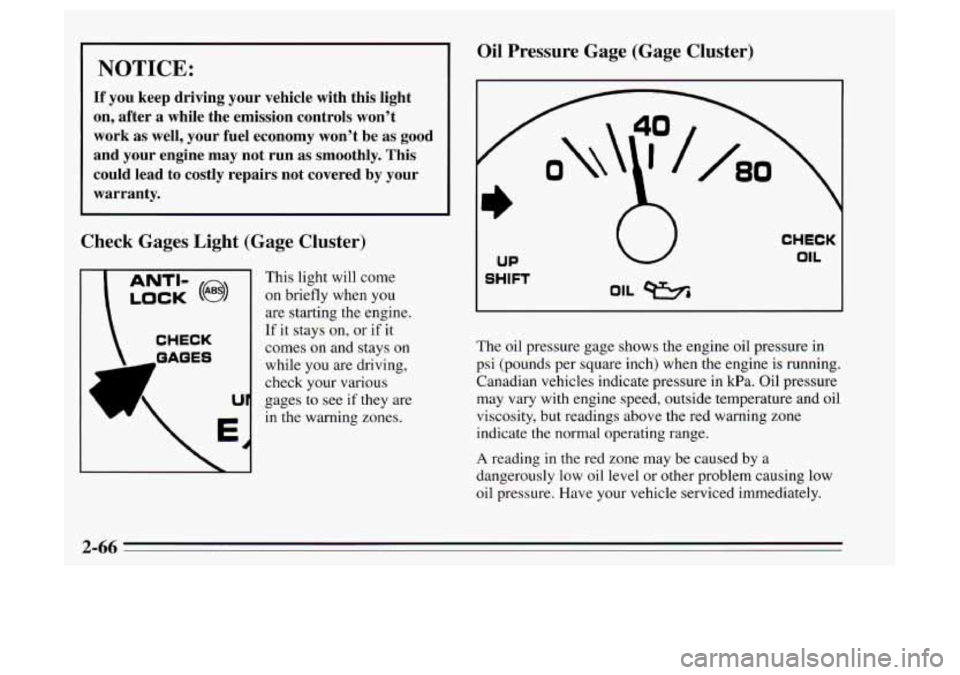
NOTICE:
If you keep driving your vehicle with this light
on, after a while the emission controls won’t
work as well, your fuel economy won’t be as good
and your engine may not run as smoothly. This
could lead to costly repairs not covered by your
warranty.
Check Gages Light (Gage Cluster)
9 ANTI-
CHECK
Q
OAOES
UI
E 4
This light will come
on briefly when you
are starting the engine.
If it stays on, or if
it
comes on and stays on
while you are driving,
check your various
gages to see if they are
in the warning zones.
Oil Pressure Gage (Gage Cluster)
UP
SHIFT
CHECK
OIL
The oil pressure gage shows the engine oil pressure in
psi (pounds per square inch) when the engine is running.
Canadian vehicles indicate pressure in kPa. Oil pressure
may vary with engine speed, outside temperature and oil
viscosity, but readings above the red warning zone
indicate the normal operating range.
A reading in the red zone may be caused by a
dangerously low oil level or other problem causing low
oil pressure. Have your vehicle serviced immediately.
2-66
Page 124 of 340
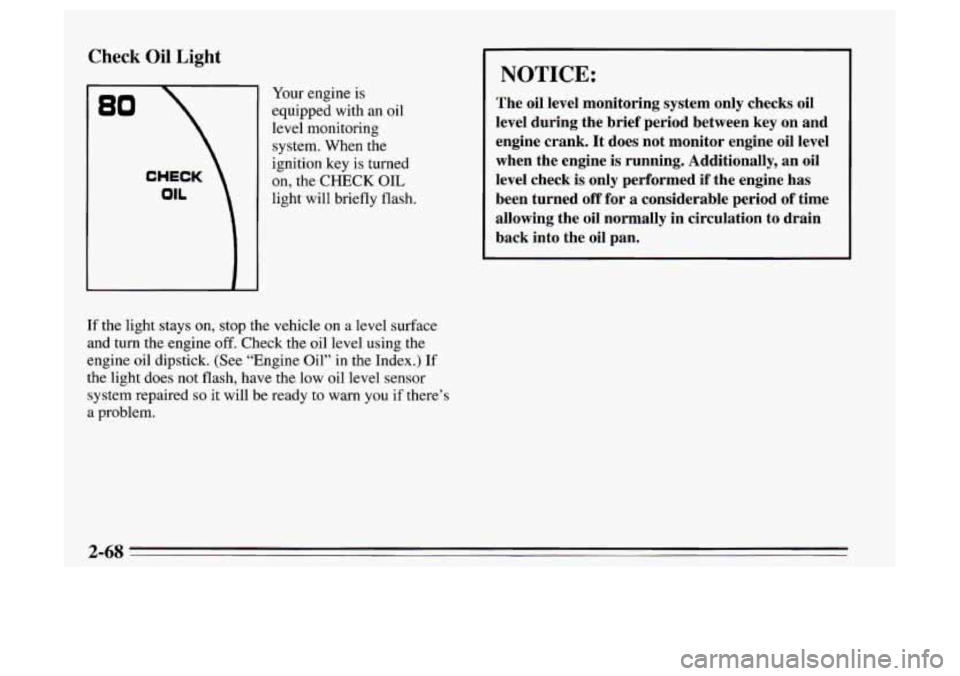
Check Oil Light
80
Your engine is
equipped with
an oil
level monitoring
system. When the
ignition key is turned
on, the CHECK
OIL
light will briefly flash.
If the light stays on, stop the vehicle on a level surface
and turn the engine
off. Check the oil level using the
engine oil dipstick. (See “Engine Oil” in the Index.)
If
the light does not flash, have the low oil level sensor
system repaired
so it will be ready to warn you if there’s
a problem.
I NOTICE:
The oil level monitoring system only checks oil
level during the brief period between key on and
engine crank.
It does not monitor engine oil level
when the engine is running. Additionally, an oil
level check is only performed if the engine has
been turned
off for a considerable period of time
allowing the oil normally in circulation to drain
back into the oil pan.
2-68
Page 141 of 340
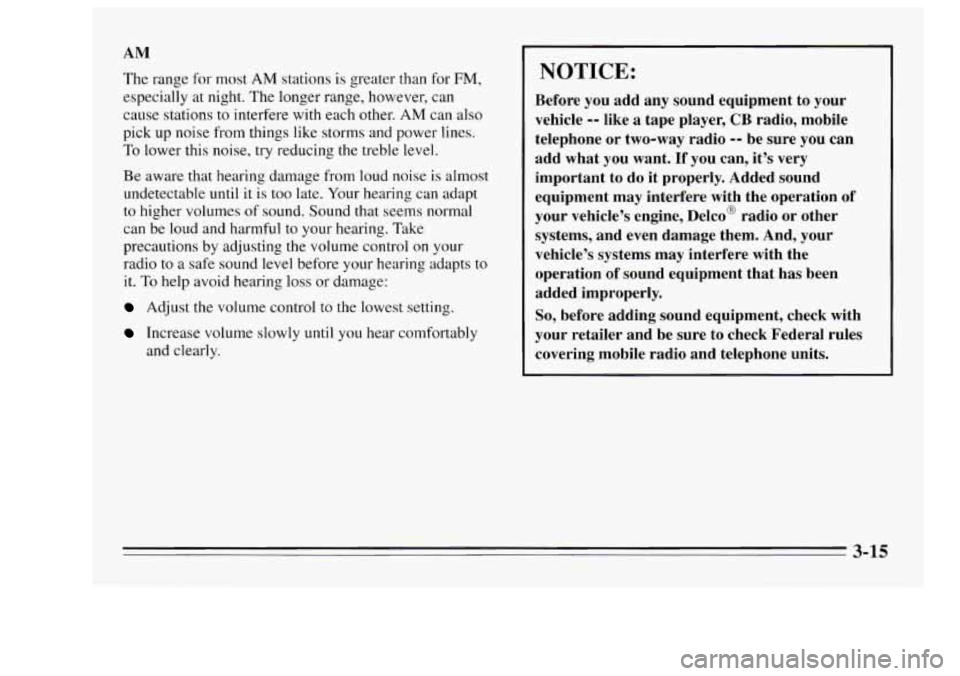
AM
The range for most AM stations is greater than for FM,
especially at night. The longer range, however, can
cause stations to interfere with each other.
AM can also
pick up noise from things like storms and power lines.
To lower this noise, try reducing the treble level.
Be aware that hearing damage from loud noise is almost
undetectable until it is too late. Your hearing can adapt
to higher volumes of sound. Sound that seems normal
can be loud and harmful to your hearing. Take
precautions by adjusting the volume control
on your
radio to a safe sound level before your hearing adapts to
it.
To help avoid hearing loss or damage:
Adjust the volume control to the lowest setting.
Increase volume slowly until you hear comfortably
and clearly.
NOTICE:
Before you add any sound equipment to your
vehicle
-- like a tape player, CB radio, mobile
telephone
or two-way radio -- be sure you can
add what you want. If you can, it’s very
important to do it properly. Added sound
equipment may interfere with the operation of
your vehicle’s engine, Delco@ radio or other
systems, and even damage them. And, your
vehicle’s systems may interfere with the
operation
of sound equipment that has been
added improperly.
So, before adding sound equipment, check with
your retailer and be sure
to check Federal rules
covering mobile radio and telephone units.
3-15
Page 150 of 340
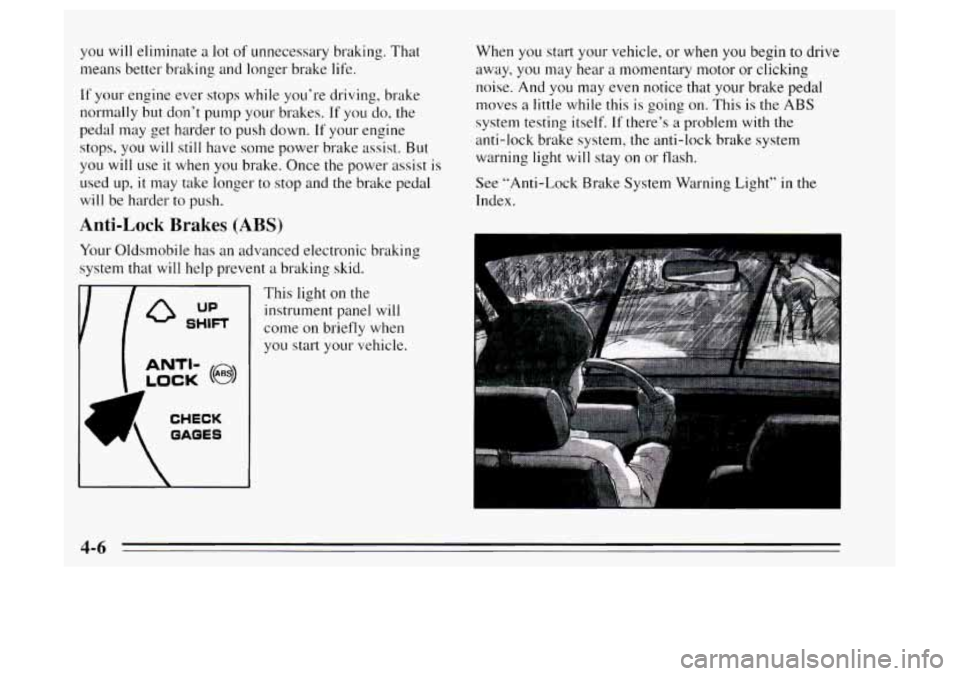
you will eliminate a lot of unnecessary braking. That
means better braking and longer brake life.
If your engine ever stops while you’re driving, brake
normally but don‘t pump your brakes.
If you do, the
pedal may get harder
to push down. If your engine
stops, you
will still have some power brake assist. But
you will use it when you brake. Once the power assist is
used up,
it may take longer to stop and the brake pedal
will
be harder to push.
Anti-Lock Brakes (ABS)
Your Oldsrnobile has an advanced electronic braking
system that
will help prevent a braking skid.
I LOCK @)
ANTI-
CHECK
OABES
This light on the
instrument panel
will
come on briefly when
you start your vehicle. When you
start yo~~r vehicle, or when
you begin to drive
away, you may hear a momentary motor or clicking
noise. And you may even notice that your brake pedal
moves a little while this is going on.
This is the ABS
system testing itself.
If there’s a problem with the
anti-lock brake system, the anti-lock brake system
warning light
will stay on or flash.
See “Anti-Lock Brake System Warning Light”
in the
Index.
4-6